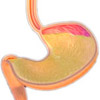Introduction to heartburn
- What is heartburn?
- Causes of heartburn
- Signs and symptoms of heartburn
- Treatment of heartburn
Introduction to heartburn
Heartburn is the common classical symptom of the disorder gastro-oesophageal reflux disease (GORD). Heartburn is experienced as a gripping, substernal (below the breastbone) discomfort that may be made worse by lying, eating or bending. In some cases heartburn may be confused with cardiac chest pain but the former is relieved by antacids whilst pain associated with ischaemic heart disease is relieved by nitrate sprays.
Heartburn is extremely common in the Australian population and is most cases can be easily managed with simple lifestyle changes and over-the-counter antacid medications. However, if the pain is persistent you may require further investigations as severe disease can progress to adenocarcinoma of the oesophagus. This is a type of cancer that develops in a very small number of patients.
What is heartburn?
Heartburn is the hallmark symptom of gastro-oesphageal reflux disease (GORD) and a common complaint amongst the general population. Heartburn is described as an intermittent retrosternal (behind the breastbone) burning discomfort that is exacerbated by eating, lying down, bending, stooping or straining. The pain is typically central but it may spread across the chest and into the neck and may be mistaken for the pain associated with ischaemic heart disease.
Virtually everyone will experience some mild heartburn at some time during their lives whilst up to 20% of the population will experience it weekly and 40% on a monthly basis. Doctors are faced with the challenge of deciding who needs further investigation for this extremely common complaint to identify those patients with gastro-oesophageal reflux that may progress to oesophagitis (erosion and destruction of the lining of the oesophagus), cellular morphological changes (called Barrett’s oesophagus) and occasionally adenocarcinoma.
 |
For more information, see Adenocarcinoma of the Oesophagus and Barrett’s Oesophagus. |
Causes of heartburn

There are a number of conditions that can predispose to dysfunction of the lower oesophageal sphincter or make heartburn symptoms worse. These include:
- Hiatus hernia– In this condition the top part of the stomach pushes up through a defect in the diaphragm (a muscular structure dividing the chest from the abdomen). This causes weakening of the sphincter and upsets the stomach’s closure mechanisms. Food is more likely to propel back from the stomach to the oesophagus.
- Obesity.
- Pregnancy- Presumably predisposes to reflux due to increased abdominal pressure and loosening of ligaments and muscles (including those of the sphincter mechanism in the diaphragm) in the body in preparation for childbirth.
- Smoking and alcohol consumption.
- Medications- Certain medications used to treat blood pressure problems, depression or asthma have been associated with heartburn symptoms. If you suspect one of your medications is causing heartburn do not hesitate to consult your doctor.
Signs and symptoms of heartburn
In many cases the doctor can make the diagnosis of your condition from history of your symptoms alone. They will ask you detailed questions about the location of the pain and whether it spreads anywhere. The timing of the pain in relationship to meals, effects of posture and duration of the pain is also important information. Your doctor will also ask questions about your diet, smoking, alcohol and current medications. You will also be questioned about other symptoms such as blood or black material in your vomit or stools. In particular, weight loss and difficulty swallowing are important symptoms as they may suggest a serious problem.
Not all patients will have the classic symptoms of heartburn and sometimes your symptoms may seem more like a respiratory problem such as a cough or wheeze at night. Along with chest discomfort you may also have other symptoms of oesophageal dysfunction including:
- Difficulty swallowing.
- Painful swallowing due to damage to the lining of the oesophagus.
- Acid regurgitation.
- Excessive salivation.
Unfortunately the severity of your symptoms does not correspond well with the severity of the damage to your oesophagus. This is a problem if patients have mild symptoms but there is extensive damage that may progress to more sinister conditions.
In many cases no further investigation is required, particularly if you are young with longstanding classic symptoms of heartburn. However, if you are older or you doctor is concerned they may order further tests to confirm the diagnosis of reflux and grade the severity.
These tests may include:
- Upper gastrointestinal endoscopy and biopsy (tissue sampling)- This lets the doctor visualise damaged areas. Tissue samples can help exclude early precancerous changes.
- Barium studies– This may detect a hiatus hernia.
- Manometry- A tube is inserted down the nose to measure the pressures generated by the lower oesophageal sphincter.
- Oesophageal pH monitoring- This is done over a 24 hour period with a special device positioned in the lower oesophagus. The device can detect reflux episodes by the degree of acidity.
Treatment of heartburn

- Lose weight if overweight.
- Raise the head of the bed- Placing blocks or bricks securely under the legs of the head of the bed can reduce the risk of stomach contents flowing back up into the oesophagus.
- Eat small, regular meals and avoid intake of food or beverages within three hours of bedtime. Avoid lying, bending or exercising just after eating.
- Avoid drugs such as NSAIDs that damage the oesophageal mucosa and drugs that impair oesophageal motility (nitrites, anticholinergics, certain antidepressants etc.). ask your doctor for advice regarding your current medications.
- Avoid smoking and alcohol.
- Avoid foods that are known to exacerbate your symptoms such as spicy foods, tomatoes, citris fruits and peppermint.
- Reduce stress.

- Antacids: For example Mylanta can neutralise stomach acid and is available at chemists and supermarkets. They can however alter bowel motions and cause fluid retention.
- Alginates: These are also over-the-counter drugs and work by forming a gel or ‘foam raft’ on top of the stomach contents to provide a physical barrier to reflux. If the above two types of drugs do not relieve symptoms within four weeks it is best to see a doctor who may arrange an endoscopy investigation (tube with a camera down the throat to have a look).
- Acid suppression therapy: Your doctor can prescribe two classes of drugs called H2-receptor antagonist or Proton-pump inhibitors (PPIs) which markedly reduce acid production. The latter is the best treatment for severe disease and can be used long-term to prevent recurrence. Your doctor may also try agents that speed up the stomach’s emptying activity to reduce reflux.
In a small number of patients surgery is indicated. This is only suitable if you have very severe symptoms of heartburn and the condition is confirmed by radiology or pH-monitoring. Surgery is normally done laparoscopically (key-hole surgery) and aims to fix defects in the diaphragm and sphincter mechanism. This may be considered a favourable option for young patients who would require long-term maintenance therapy.
More information
 |
For more information on acid reflux and heartburn and related investigations, treatments and supportive care, see Acid Reflux and Heartburn. |
References
- de Caestecker J. ABC of the upper gastrointestinal tract. Oesophagus: Heartburn. BMJ. 2001;323(7315):736-9. [Abstract | Full text]
- Cohen S, Parkman HP. Heartburn: A serious symptom. N Engl J Med. 1999;340(11):878-9. [Abstract]
- Kumar P, Clark M (eds). Clinical Medicine (5th edition). Edinburgh: WB Saunders Company; 2002. [Publisher]
- Longmore M, Wilkinson I, Rajagopalan S. Oxford Handbook of Clinical Medicine (6th edition). Oxford: Oxford University Press; 2004. [Publisher]
- Longstreth GF. Heartburn [online]. Bethesday, MD: MedlinePlus; 2005. Available from: URL link
- Talley N, Moore M, Sprogis A, Katelaris P. Randomised controlled trial of pantoprazole versus ranitidine for the treatment of uninvestigated heartburn in primary care. Med J Aust. 2002;177(8):423-7. [Abstract | Full text]
- Product Information: Somac Heartburn Relief Tablets. North Ryde, NSW: Nycomed Pty Ltd; 31 July 2008.
- Fox M. Gastro-oesophageal reflux disease. Clinical review. BMJ. 2006; 332: 88-93. [Abstract | Full text]
- Duggan AE. The management of upper gastrointestinal symptoms- is endoscopy indicated? Med J Aust. 2007; 186(4): 166-7. [Full Text]
- Braunwald E, Fauci AS, Kasper DL, et al. Harrison’s Principles of Internal Medicine (15th edition). New York: McGraw-Hill Publishing; 2001. [Publisher]
- Tierney LM, McPhee SJ, Papadakis MA (eds). Current Medical Diagnosis and Treatment (45th edition). New York: McGraw-Hill; 2006. [Publisher]
- DeVault KR, Castell DO. Updated guidelines for the diagnosis and treatment of gastroesophageal reflux disease. Am J Gastroenterol. 2005; 100(1): 190-200. [Abstract]
- Murtagh J. General Practice (3rd edition). Sydney: McGraw-Hill; 2003. [Publisher]
All content and media on the HealthEngine Blog is created and published online for informational purposes only. It is not intended to be a substitute for professional medical advice and should not be relied on as health or personal advice. Always seek the guidance of your doctor or other qualified health professional with any questions you may have regarding your health or a medical condition. Never disregard the advice of a medical professional, or delay in seeking it because of something you have read on this Website. If you think you may have a medical emergency, call your doctor, go to the nearest hospital emergency department, or call the emergency services immediately.








